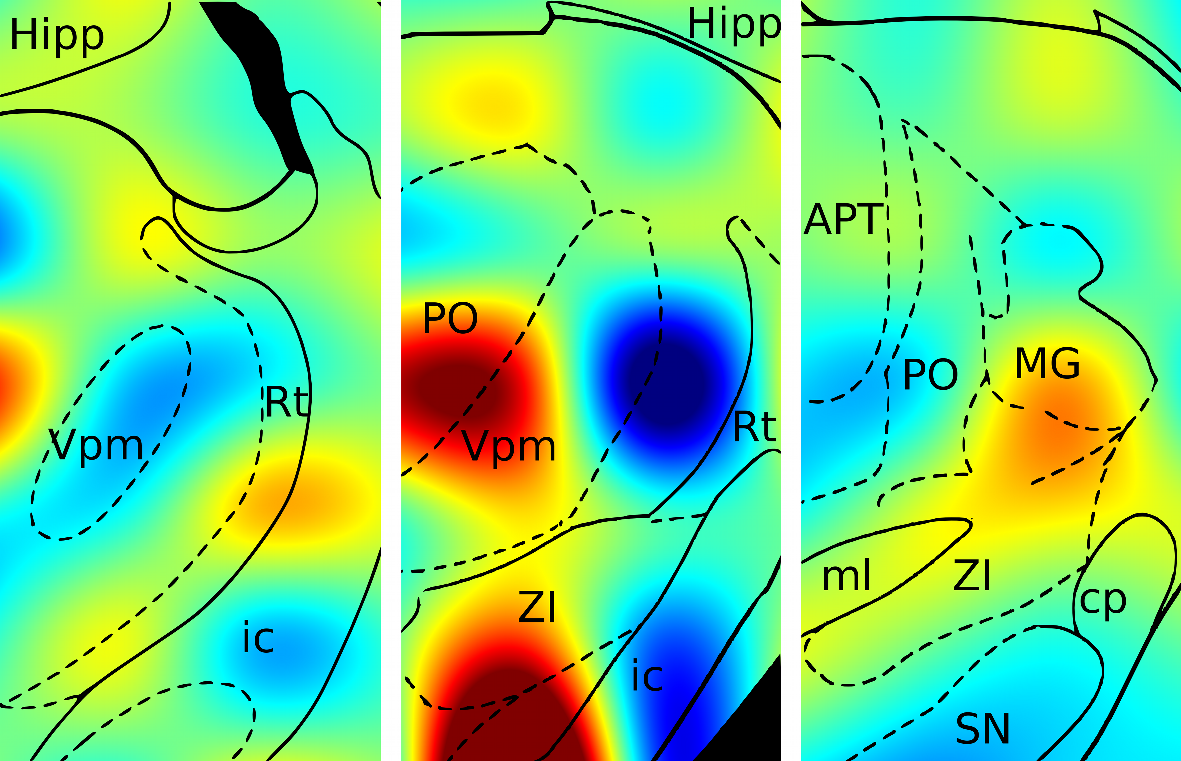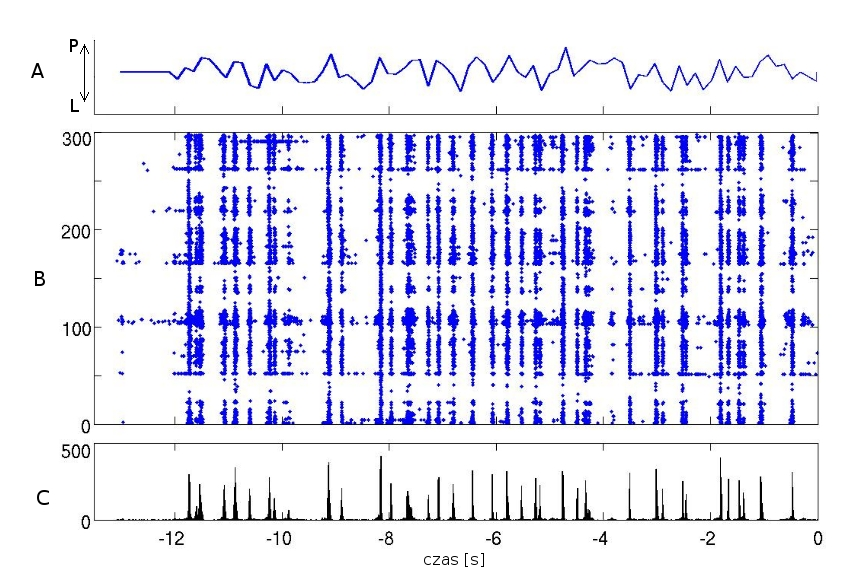|
Please check our new lab website
.
My
general aim is the development of analysis tools and models to understand
the dynamics in neural tissue during processing of
sensory information. I am particularly interested in functioning of
early levels of sensory systems, in particular thalamo-cortical loops, but we also study
the extrageniculate pathway of the visual system. For other projects we run see
www.3dbar.org
service.3dbar.org or this movie of extracellular potential generated by the cortical column in a thalamo-cortical network.
Reconstruction of current source density in many dimensions for realistic
geometries of recording setups
Electric potential measured extracellularly in the brain (Local Field
Potential, LFP) carries information about activity of neural
populations which can be remote from the place of recording. To find
out the local cellular activity one must reconstruct the current
source density (CSD) generating the measured field. We developed a
method allowing precise reconstruction of CSD in three dimensions
from a set of recordings obtained on a Cartesian grid (Łęski et
al., 2007, Wójcik and Łęski, 2009). In
collaboration with Gaute Einevoll's group from University
of Life Sciences, Ås, Norway, we are currently developing a similar method in 2D for analysis of
recordings from electrode arrays. In the long term we would like to construct
a general variant which would not require recording positions on
a specific grid and would be able to deal with any realistic
geometry of electrode contacts. We are developing an open toolbox implementing our
methodology which will be distributed freely in the community.
Our 3D method is used for analysis of dynamics of thalamic
activation in stimulation of somato-sensory pathway in
anesthetized rat and activity in the barrel cortex in
behaving rats. Both projects are in collaboration with Ewa Kublik
and Andrzej Wróbel, IBD PAN. Two dimensional data to be
analyzed come from the laboratory of John Gigg from University
of Manchester, UK, from experiments in the subiculum and were
obtained with a multishaft electrode giving 8x8 simultaneous
recordings on a grid of 200 μm interelectrode distance.
In
collaboration with Gaute Einevoll's group from University
of Life Sciences, Ås, Norway, we are currently developing a similar method in 2D for analysis of
recordings from electrode arrays. In the long term we would like to construct
a general variant which would not require recording positions on
a specific grid and would be able to deal with any realistic
geometry of electrode contacts. We are developing an open toolbox implementing our
methodology which will be distributed freely in the community.
Our 3D method is used for analysis of dynamics of thalamic
activation in stimulation of somato-sensory pathway in
anesthetized rat and activity in the barrel cortex in
behaving rats. Both projects are in collaboration with Ewa Kublik
and Andrzej Wróbel, IBD PAN. Two dimensional data to be
analyzed come from the laboratory of John Gigg from University
of Manchester, UK, from experiments in the subiculum and were
obtained with a multishaft electrode giving 8x8 simultaneous
recordings on a grid of 200 μm interelectrode distance.
Collaboration: A. Wróbel, E. Kublik, IBD PAN, Warsaw, Poland; G. Einevoll, UMB, Ås, Norway; J. Gigg,
UM, Manchester, UK.
Modeling thalamocortical loop
Our method of reconstruction of CSD from recordings on a finite grid makes certain assumptions which are difficult to establish experimentally but can be profitably investigated in realistic models. Models of different types provide also the best framework for testing various methods of data analysis, since every detail can be controlled there. We plan to develop several different models of the thalamocortical loop of rat somatosensory system. So far we have constructed a simple neural field model to test methods for measuring synchronization in this system (Łęski and Wójcik, 2008). We plan to develop a large-scale realistic model to model the LFP and CSD activity in the thalamus and cortex after stimulation of rat vibrissa. To do it we will use a methodology to automatically generate populations of realistic neuron models using L-systems – an approach from fractal geometry used to describe complex random morphologies in a synthetic way. This approach has been extensively explored in neuroscience by G. Ascoli at George Mason University. However, it has not been used for the evaluation of potentials generated by populations of such neurons. We should be able to combine fractal geometry (Wójcik, 2000) with biophysics to obtain reasonable estimates of fields generated in the tissue by populations of different cells and with network dynamics.
Collaboration: A. Wróbel, IBD PAN, Warsaw, Poland
Coding and variability in extrageniculate visual pathway
Coding and decoding of sensory information in the brain is one of the outstanding problems of neuroscience. It is particularly striking given the variability of neural responses and the stability of our percepts.  A natural approach to the problem of coding is through the theory of probability and information theory (Rieke et al., 1997). We are working to understand the coding properties and variability of responses of cells in superior colliculus, the major structure in the extrageniculate visual pathway.
We are building quantitative point process models
to describe activity of every cell. We call it “spike kinematics” as it
is separate from membrane mechanism (“spike dynamics”) but it puts
constraints on possible models of spike generation. The long-term goal
is to find realistic models of these cells based on available
morphological and biophysical data satisfying the constraints. A natural approach to the problem of coding is through the theory of probability and information theory (Rieke et al., 1997). We are working to understand the coding properties and variability of responses of cells in superior colliculus, the major structure in the extrageniculate visual pathway.
We are building quantitative point process models
to describe activity of every cell. We call it “spike kinematics” as it
is separate from membrane mechanism (“spike dynamics”) but it puts
constraints on possible models of spike generation. The long-term goal
is to find realistic models of these cells based on available
morphological and biophysical data satisfying the constraints.
A crucial component of neural codes is provided by correlations among different cells. To study such effects in the visual system we will analyze simultaneous recordings from multiple cells in different structures of geniculate and extrageniculate visual pathways of the cat (data provided by W. Waleszczyk, IBD PAN). We plan development, application and testing of different synchronization and cooperation methods obtained within information theory and dynamical systems approach once the data become available.To test the viability of these methods we will also develop models of networks of spiking neurons with different topologies and check to which extent the considered methods are able to extract these topologies.
Collaboration: A. Wróbel, W. Waleszczyk IBD PAN, Warsaw, Poland
Physics
I was trained as a theoretical physicist. I finally specialized in the dynamical systems approach to nonequilibrium statistical mechanics. Within these bounds
I was recently studying the transport properties of disordered quantum multiplexer maps. I am also interested in classical extended systems exhibiting spatiotemporal chaos, such as Complex Ginzburg-Landau Equation. Collaboration: J. R. Dorfman, UMD, College Park, USA; N. Garnier, ENS, Lyon, France This page updated June 16, 2009.
|